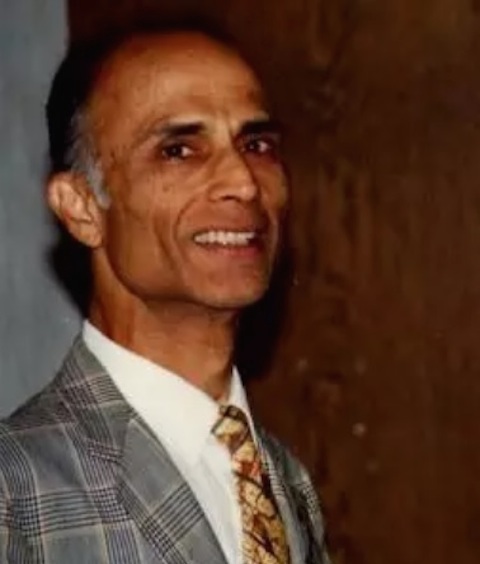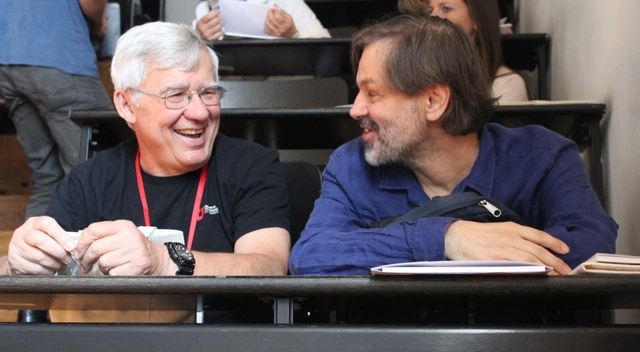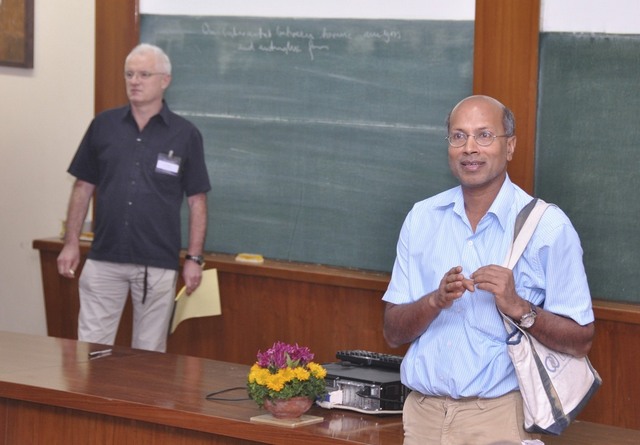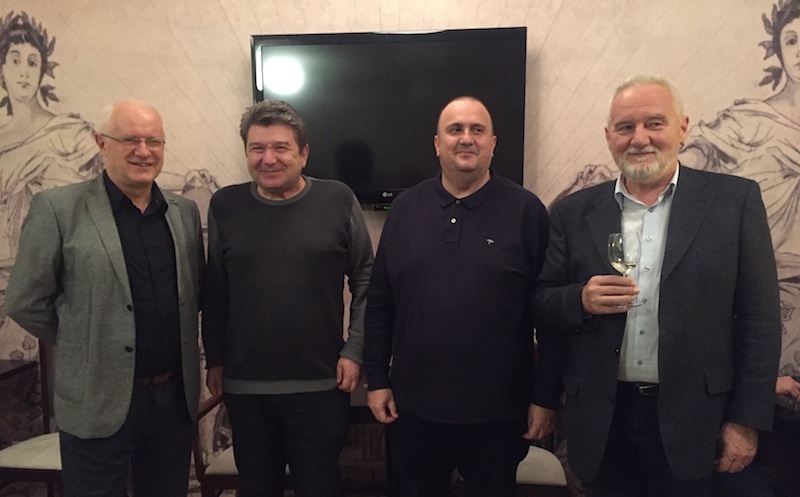|
Dipendra Prasad, president of Indian Math Society, speaking about Ramanujan, Harish Chandra, and Croatian mathematicians
Tomislav Šikić, Associate Professor of Mathematics at the University of Zagreb, Faculty of Electrical Engineering and Computing
Summary. Tomislav Šikić, Associate Professor of Mathematics at the University of Zagreb, delivered a lecture dedicated to Srinivasa Ramanujan, the most famous Indian mathematician in history. Croatian mathematicians have contributed twelve scientific papers in The Ramanujan Journal. Also, as many as 23 Indian mathematicians are (or have been) members of specialized math journals in Croatia, published by Element co. Two Croatian mathematicians, Professors Hrvoje Šikić and Zoran Vondraček, have earned their PhD's under the guidance of distinguished Indian mathematician Murali Rao, University of Florida, USA. A few Croatian mathematicians were invited lecturers in Indian scientific institutions.
|
Izv. prof. dr. Tomislav Šikić (Sveučilište u Zagrebu, Fakultet elektrotehnike i računarstva - FER) je u organizaciji veleposlanstva Republike Indije i Hrvatsko-indijskog društva 15. prosinca 2021. održao predavanje o najistaknutijem indijskom matematičaru povijesti, pod naslovom "Srinivasa Ramanujan - kao most iznad oceana". Predavanje je održano u Hrvatskom kulturnom društvu Napredak u Zagrebu. Tribinu je vodio prof. dr. Darko Žubrinić, djelatnika FER-a (Zavod za primijenjenu matematiku).
Uz nazočnost brojnih matematičara i drugih gostiju, skup je pozdravio Nj. E. g. Raj Kumar Srivastava, veleposlanik Indije. Profesor Šikić je među inim naglasio da se rođendan (22. prosinca) Srinivase Ramanujana u Indiji svake godine obilježava kao "Nacionalni dan matematike". Pri kraju programa se skupu iz Indije (putem Zooma) javio profesor Dipendra Prasad, predsjednik Indijskog matematičkog društva, koji je u svojem referatu visoko ocijenio doprinose hrvatskih matematičara u teoriji reprezentacija. Među slušačima bili su akademici Marko Tadić, Andrej Dujella (obojica matematičari) i Mislav Ježić (indolog). Došla je i mala grupa mladih indijskih matematičara koji borave na poslijediplomskim studijima matematike na Sveučilištu u Zagrebu.
Održavanju tribine je 11. studenog 2021. prethodio posjet profesora Tomislava Šikića veleposlaniku Republike Indije Nj. E. Raj Kumar Srivastavi, u pratnji g. Joginder Singh Nijjara (predsjednika Hrvatsko-indijskog društva) i Darka Žubrinića (djelatnika FER-a), gdje je tijekom razgovora bilo riječi o unaprijeđenju suradnje Hrvatske i Indije u području matematičkih znanosti. G. veleposlanik (inženjer geoznanosti i seizmologije) i njegova supruga Lakshmi (filologinja) su veliki ljubitelji matematike i bridža. Zahvaljujemo prof. dr. Nevenu Elezoviću (djelatniku FER-a u miru) na njegovu priručniku za učenje bridža za studente FER-a koji smo s njegovom posvetom darovali veleposlaniku, kao i na dvjema edukativnim slikovnicama za predškolsku djecu tiskanim u Indiji na hrvatskom jeziku, u suradnji s poduzećem Element u Zagrebu.
| 
Darko Žubrinić openinig a meeting at the Napredak (Advancement) Society in Zagreb. In the first row from the left:
H. E. Mr. Raj Kumar Srivastava with his wife Lakshmi, then Mr. Joginder Singh Nijar (president of Croatian-Indian Society in Zagreb),
Professor Marko Tadić (of the Croatian Academy of Sciences and Arts, HAZU), and Tomislav Šikić (Associate Professor, University of Zagreb)

Introductory address of H. E. Mr. Raj Kumar Srivastava, ambassador of the Republic of India to Croatia.

Tomislav Šikić, Associate Professor of Mathematics at the University of Zagreb (Faculty of Electrical Engineering and Computing),
delivering his lecture about Srinivasa Ramanujan, at the Croatian cultural society Napredak in Zagreb on 15th December 2021 
The title page of Tomislav Šikić's presentation about Srinivasa Ramanujan
There are presently as many as three scientific math journals bearing the name of Ramanujan: - The Ramanujan Journal (An International Journal Devoted to the Areas of Mathematics Influenced by Ramanujan)
- Journal of the Ramanujan Mathematical Society
- Mathematics Newsletter of the Ramanujan Mathematical Society
In The Ramanujan Journal, 12 scientific papers have been contributed by Croatian mathematicians:
- Antun Milas (in collaboration with S. Caparelli and J. Lepowski, 2006)
- Andrej Dujella (2008)
- Zrinka Franušić (2008)
- Goran Muić (2010)
- Goran Muić (2012)
- Miroslav Jerković (2012)
- Matija Kazalicki (2014)
- Filip Najman (in collaboration with Pieter Bruin, 2016)
- Iva Kodrnja (2018)
- Ivana Baranović, Mirko Primc, and Goran Trupčević (2018)
- Mirko Primc and Tomislav Šikić (2019)
- Sonja Žunar (2020)
- Iva Kodrnja and Goran Muić (2021)
About a dozen of Croatian mathematicans have joint papers with Indian mathematicians.
According to information provided by the courtesy of Professor Neven Elezović, as many as 23 Indian mathematicians are (or have been) members of specialized scientific math journals published by Element co. in Croatia's capital Zagreb (JCA- Journal of Classical Analysis, JMI- Journal of Mathematical Inequalities, MIA- Mathematical Inequalities and Applications, FDC- Fractional Differential Equations, DEA- Differential Equations and Matrices, OaM- Operators and Matrices):
- Vijay Gupta (JCA, JMI)
- Prasanna Kumar (JCA)
- Vishnu Narayan Mishra (JCA)
- Ram. N. Mohapatra (JCA, MIA)
- Saminathan Ponnusamy (JCA)
- Girja S. Srivastava (JCA)
- Hari M. Srivastava, Victorija (JCA, JMI, FDC, MIA)
- Vasudeva Rao Allu (JMI),
- Mohammad Mursaleen (JMI),
- Pankaj Jain (ex JMI),
- Ravi P. Agarwal (MIA),
- Abdul Aziz (ex MIA),
- Rajendra Bhatia (ex MIA),
- V. Lakshmikantham (MIA),
- Baburao G. Pachpatte (MIA),
- Ram U. Verma (MIA),
- Gadadhar Misra (OaM),
- T.S.S.R.K. Rao (OaM),
- Rajendra Bhatia (OaM),
- Praveen Agarwal (DEA),
- Bapurao C. Dhage (DEA),
- Varsha Daftardar-Gejji (FDC),
- J. Vasundhara Devi (FDC)
Two Croatian mathematicians, Professors Hrvoje Šikić and Zoran Vondraček, earned their PhD's under the guidance of Professor Murali Rao, distinguished Indian mathematician, employed at the University of Florida, USA. He was on several occasions a guest of the University of Zagreb, as well as of the Inter-University Center in Dubrovnik.
| 
Lecture Hall of the Napredak Society in Zagreb

Professsor Dipendra Prasad, president of Indian Mathematical Society, addressing from India 
H. E. Mr. Raj Kumar Srivastava and academician Marko Tadić in a direct contact with Professor Dipendra Prasad in India.
Ramanujan, Harish-Chandra, and the Croatian Mathematics
Dipendra PrasadIndian Institute of Technology Bombay, Mumbai I feel honored to be talking in front of this august audience which includes many of my Croatian friends. I feel rather privilged to belong to a country where two of the greatest mathematicians of the twentieth century, Srinivasa Ramanujan (1887-1920) and Harish-Chandra (1923-1983) were born. Srinivasa RamanujanSrinivasa Ramanujan was born in a small town of South India, named Kumbhakonam on December 22, 1887. (Now, December 22 is celebrated in India as the National Mathematics Day.) Ramanujan had no training in mathematics and no access to conven- tional mathematical literature. He discovered large number of results in mathematics which he compiled in his "notebooks" without giving any proofs.
Srinivasa Ramanujan (1887-1920)
After many unsuccessful efforts in getting the attention of some of the prominent mathematicians of his times in his work, Ramanujan wrote to G H Hardy on January 16, 1913, a nine page letter containing some of the theorems from his notebooks. Coming from an unknown person, Hardy initially viewed Ramanujan's manuscripts as a possible fraud. Hardy could recognise some of Ramanujan's formulae but others seemed scarcely possible to believe. Hardy said that some of the results contained in his letters defeated him completely. He had never seen anything in the least like them before, and that they "must be true, because, if they were not true, no one would have the imagination to invent them". Hardy concluded that the letters were "certainly the most remarkable I have received" and that Ramanujan was "a mathematician of the highest quality, a man altogether of exceptional originality and power".
On February 8, 1913, Hardy wrote Ramanujan a letter expressing interest in his work, adding that it was "essential that I should see proofs of some of your assertion". Before his letter arrived in Madras during the third week of February, Hardy had contacted the Indian Office in Madras to plan for Ramanujan's trip to Cambridge. Secretary Arthur Davies of the Advisory Committee for Indian Students met with Ramanujan to discuss the overseas trip. In accordance with his Brahmin upbringing, Ramanujan refused to leave his country to "go to a foreign land". However, at the suggestion of some of his well wishers, Ramanujan soon got convinced about traveling to Cambridge but not his parents. Eventually, his parents too yielded. Apparently Ramanujan's mother had a vivid dream in which the family Goddess, the deity of Namagiri, commanded her "to stand no longer between her son and the fulfilment of his life's purpose". On March 17, 1914, Ramanujan traveled to England by ship, arriving there on April 14, 1914. Hardy and Ramanujan collaborated intensely for about 5 years from 1914 to 1919. Ramanujan who was a strict vegetarian had a hard time in England. He was diagnosed with tuberculosis and a severe vitamin deficiency, and was confined to a sanatorium. Ill health brought Ramanujan back to India in 1919 and he died next year in 1920, at the age of 32.
In the last year of his life, Ramanujan discovered mock theta functions. For many years these functions were a mystery, but in the last decade or two, they are getting related to more conventional theory of modular forms, still somewhat exotic, and are a source of innumerable research publications. Perhaps it will take another few decades to understand them fully.
The genius of Ramanujan was well recognized early-on both in the world of mathematics and in India, perhaps because of G H Hardy, one of the most prominent mathematicians of the first half of the twentieth century. It is fair to say that Ramanujan is a house hold name in India, and definitely anyone remotely connected with mathematics knows something about him. Selberg said on the Ramanujanâs centenary in 1987, that he encountered the collected works of Srinivasa Ramanujan at the age of 17 (so, it would be the year 1934!) which was a major influence in directing him into mathematics.
Ramanujan left a deep impression on Hardy and Littlewood. Littlewood said of him, "I can believe that he's at least a Jacobi", while Hardy said he can compare him "only with Euler or Jacobi." It is impressive to see these accolades coming to Ramanujan when what we consider now as the most remarkable of his investigations, that on arithmetical properties of what is called the Ramanujan tau-function, had left no impressions on his contemporaries, and that the "lost book", and the "mock modular forms" would take another century to start to integrate into mathematics.
Harish-Chandra
India has the honor of having had another truly remarkable mathematician, Harish-Chandra, born on October 11, 1923, in Kanpur, in an affluent family, which is in the same state that I come from. Harish-Chandra studied in Allahabad University in Allahabad where there is now the Harish-Chandra Research Institute where I was for many years.
 Harish-Chandra (1923-1983)
Harish-Chandra began his career as a physicist, wrote many papers with Homi-Bhabha (who founded the Tata Institute of Fundamental Research), and who sent him to Dirac in Cambridge, England in 1945 from whom he got his doctorate in 1947, on questions that interested Dirac then, which were close to infinite dimensional representation theory of the Lorentz group SO(3, 1). Harish-Chandra accompanied Dirac to the Institute for Advanced Study in 1947 for a year as his "assistant," and then stayed there for another year after Dirac had returned to Cambridge, shifting his interest completely to the subject of infinite dimensional representation theory of real reductive groups, where, one can say, he began almost from the beginning and went up to the end! He also developed the representation theory of p-adic groups in close analogy. One of the high points of Harish-Chandra's works is in the two papers on Discrete series representations of semi-simple groups, about 200 pages together, which appeared in Acta Mathematica in 1965-1966, which constructed and parametrized Discrete series representations of semi-simple groups together with its contribution to the Plancherel decomposition. The explicit Plancherel decomposition was one of the initial goals that Harish-Chandra had set for himself in the early 50's which was to occupy him till the mid 70's, and this central theorem of the subject was eventually completed by him in all details. Along the way to explicit Plancherel decomposition, Harish-Chandra created all the tools which will be used by all the researchers doing Harmonic analysis: study of spherical functions, and invariant differential operators; distributions on groups as well as Lie algebras, and going back and forth between the two; study of invariant distributions, and his monumental works on characters; matrix coefficients; orbital integrals. Harish-Chandra was also known for a certain style for doing mathematics: unlike most of us, he did not deal with explicit groups, one at a time, but based his intuition on just one group SL2(R), and then went for the most general case possible - by a long and typically very intricate inductive argument (inductive both in the sense of mathematical induction, and parabolic induction), which has become the trade-mark of the subject. He even defined what's the most general group one should consider, which included disconnected groups and covering groups at the same time. These groups are called groups of the Harish-Chandra class. He is famously said to have said, thinking about explicit groups such as Sp(4, R) gives him a headache! There are many concepts which originate from Harish-Chandra, such as the Philosophy of cusp forms: a guiding and organizational principle in group theory in general, and Harish-Chandra's Lefschetz philosophy: whatever is true for real groups is true for p-adic groups, also true for automorphic representations, and also for finite groups of Lie type.I end my short account of Harish-Chandra by quoting Langlands quoting Harish-Chandra: I have often pondered over the roles of knowledge or experience, on the one hand, and imagination or intuition, on the other, in the process of discovery. I believe that there is a certain fundamental conflict between the two, and knowledge, by advocating caution, tends to inhibit the flight of imagination. Therefore, a certain naivete, unburdened by conventional wisdom, can sometimes be a positive asset.
Harish-Chandra's influence on CroatiaIt is the work of Harish-Chandra that we see well pursued by Croatian mathematicians, which from what I understand, was begun by Hrvoje Kraljević and Dragan Miličić at the end of 1960's who started systematic study of Harish-Chandra's work and made important contributions to the subject in the 70's already.
Academician Marko Tadić, distinguished Croatian mathematician
Professor Hrvoje Kraljević, served as a Minister of Science and Technology
of the Republic of Croatia in 2000-2002.
 Good friends and distinguished international experts in Representation Theory of Groups: Professors Dragan Miličić (University of Utah, USA) and Ivan Mirković (Massachusetts University, USA, a fellow of Croatian Academy of Sciences and Arts), former students of the University of Zagreb. They both started their scientific career in Croatia.
Academician Goran Muić, another distinguished Croatian mathematician
Then came Marko Tadić who got a PhD in 1980 from Zagreb, and who is now a world leader in the subject of representation theory of p-adic groups, a subject on which Harish-Chandra made the first important results. Tadić, together with his own student Goran Muić, another distinguished name in the subject, has created a very thriving school of representation theorists in Croatia.
Gordan Savin, University of Utah, USA
Of course I know all these mathematicians from Croatia very well, and some have also visited me in India. But my own contacts with Croatia are linked to my friendship with Gordan Savin who came to Harvard University for his PhD and we were contemporary students at Harvard in the mid to late 80's. Gordan is one of the most brilliant and original mathematicians that I know. Gordan continues to have great ties with Croatian mathematicians, and I know he cares a lot about Croatia.
The next generation:
Professors Ivan Matić (University of Osijek), Marcela Hanzer (University of Zagreb),
and Neven Grbac (University of Rijeka)
Thank You!
|
 Professor Dipendra Prasad, announcing an invited lecture by Professor Marko Tadić, University of Zagreb, Croatia, at the "International Colloquium on Automorphic Representations and L-Functions", organized by
the TATA Institute for Fundamental Research (TIFR) in Mumbay, January 2012. 
Mr. Joginder Nijjar Singh, president of Croatian-Indian Society, greeting all guests at the end of the lecture in Napredak. In the first row from the left: Kristijan Tabak (Associate Professor at RIT - Rochester Insitute of Technology, Zagreb), Professor Andrej Dujella (of the Croatian Academy of Sciences and Arts),
Ružica Čičak-Chand, PhD, and in the second row on the right is Professor Mislav Ježić (of the Croatian Academy of Sciences and Arts), distinguished Croatian indologist. 
At the end of the meeting dedicated to Srinivasa Ramanujan, organized on 15th December, 2021:
Mr. Krishan Kumar, ac. Marko Tadić, H. E. Raj Kumar Srivastava, Mr. Joginder Singh Nijjar, Tomislav Šikić, Associate Professor, Professor Darko Žubrinić 
Tomislav Šikić, H. E. Mr. Raj Kumar Srivastava (ambassador of the Republic of India to Croatia), Professor Darko Žubrinić,
and Mr. Joginder Singh Nijjar (president of Croatian-Indian Society) at the Embassy of India in Zagreb, 11th November 2011. 
Tomislav Šikić and Joginder Singh Nijjar in front of the building of the Embassy of India in Zagreb, 11th November 2021. 
D. Žubrinić, Mr. Joginder Singh Nijjar (president of Croatian-Indian Society) and H. E. Mr. Raj Kumar Srivastava (ambassador of the Republic of India)
in Croatian cultural society Napredak in Zagreb. The ambassador is holding in his hands a few gifts by Professor Neven Elezović
(his primer for learning the Bridge, as well as two educative booklets for children published in India, in Croatian langauge). From the meeting at Croatian cultural society Napredak after the lecture of Tomislav Šikić delivered on 15th December 2021: 
Mr. Joginder Singh Nijjar, Professor Dina Šimunić, H. E. Mr. Raj Kumar Srivastava and academician Mislav Ježić 
H. E. g. Raj Kumar Srivastava with his wife Lakshmi, with a group of young Indian mathematicians, guests of the University of Zagreb. On the left is Dr. Indranil Chowdhury, a member of the scientific project group directed by Professor Zoran Vondraček. Next to him on the left is
Mr. Sandeep Kumar Soni, doctoral student at the Department of Mathematics of the School of Science (we are grateful to Professor Nenad Antonić for this information). 
Academicians Marko Tadić and Andrej Dujella (Mathematics Department of the School of Science), Professor Dražen Adamović (editor in chief of Glasnik matematički),
and Professor Tomislav Došlić (Faculty of Civil Enginnering), all of them from the University of Zagreb. 
Željka Marija Bošnjak, Croatian astrophysicist, Associate Professor at the Faculty of Electrical Engineering and Computing, University of Zagreb,
and Mr. Joginder Singh Nijjar, president of Croatian-Indian Society.
The photos above are due to Mario Milošević and Darko Žubrinić.
|